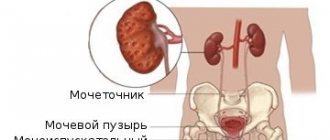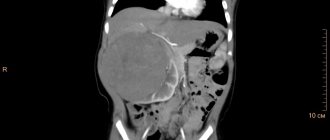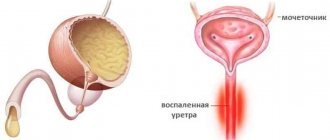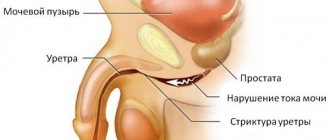Incidentaloma of the adrenal gland is a hormonally inactive tumor of the adrenal gland (“incident” in translation from English - accidental or sudden). Such tumors do not manifest themselves and are discovered completely by chance.
Until relatively recently, these tumors were diagnosed only after the death of a person, at the time of autopsy. Currently, thanks to the latest research methods, in most cases it is possible to detect adrenal incidentaloma and begin treatment in a timely manner. Hormonally inactive incidentalomas occur in both men and women. Most often these are patients over 30 years of age.
Incidentalomas are most often benign in nature and do not have hormonal secretion. But it is extremely rare to find a hormonal tumor that can develop into cancer. Incidentaloma of the hormonal direction produces cortisol. If the tumor reaches 4 cm, has a heterogeneous structure and high density, then there may be a possibility of developing oncology. If a person has already been diagnosed with cancer of another organ, then a hormonal incidentaloma that does not reach 3 cm in size is most likely a metastasis of the disease.
Symptoms of the disease
As a rule, the appearance of this formation in the adrenal glands is not accompanied by any symptoms. But in some cases, the patient may experience the following symptoms characteristic of incidentalomas:
- severe hypertension;
- seizures and changes in skin color;
- increased blood sugar;
- jumps in hormone levels characteristic of the type of education;
- sudden hair loss or growth;
- loss or increase in sexual desire;
- changes in weight towards weight gain or loss;
- headaches and dizziness;
- general deterioration of condition;
- feverish condition;
- loss of appetite;
- development of diabetes mellitus and other chronic diseases;
- disturbances in the full functioning of the kidneys.
It is worth noting that benign incidentalomas are completely asymptomatic, and this is the difficulty of identifying them. With malignant incidentalomas of large size, the patient may experience an increase in the abdominal area and severe intoxication of the body.
Classification
Benign neoplasms are classified according to tumor size, location and course characteristics. There are incidentalomas of the left and right adrenal glands, as well as bilateral ones. Based on histogenesis, primary and secondary tumors are distinguished.
Primary cancer is classified by stage and size. Secondary ones are often metastases of a malignant neoplasm in the lungs, kidneys, mammary gland, intestines, and thyroid gland.
Groups of hormonally inactive neoplasms:
- Arising from the cortex.
- Formed from the medulla.
- Arising as a result of metastasis.
The most dangerous malignant neoplasms. They metastasize to distant organs and affect the functions of the endocrine and other systems.
- Adrenal glands: symptoms and causes of the disease, their diagnosis and treatment
The formation can be found in the left adrenal gland (about a third of all patients), the right, or on both sides (an extremely rare occurrence).
Features of the tumor
Adrenal incidentalomas account for approximately 8% of tumors found in the adrenal cortex. The most vulnerable age is people 30-60 years old. In women, this pathology occurs more often than in men, possibly due to less stability of the hormonal levels in the body. The lesion is rarely bilateral; 60% are incidentalomas of the left adrenal gland.
Types of adrenal tumors
An incidentaloma is any type of tumor found on the adrenal gland. When it is detected, further diagnostics are needed to determine the type of tumor and its potential aggressiveness and danger. The first step is to determine the hormonal activity of the neoplasm and determine its type accordingly.
Hormone-producing tumors
- Corticosteroma – increased cortisol levels.
- Pheochromocytoma is a tumor that produces stress hormones.
- Aldosteroma is accompanied by increased production of aldosterone.
- Androsterome increases testosterone levels.
- Corticoestroma enhances the production of estrogen.
Hormonally inactive tumors
- Adenoma is a neoplasm with a dense capsule.
- Lipoma is a benign neoplasm of fat cells.
- Fibroma is a tumor with the formation of a capsule with fibrous contents.
- Malignant tumors: adrenocortical cancer, sarcoma.
In addition, there is a group of adrenal neoplasms that are not tumors. These are cysts, hematomas, tissue hyperplasia. In these cases, an incidentaloma of the right adrenal gland, as well as the left or both at once, can be diagnosed.
Therapeutic measures
Hormonally inactive adrenal tumors are not treated according to a single scheme, since the tactics will be chosen depending on the type of tumor, whether it is malignant or benign.
If the incidentaloma grows to 6 cm, surgical intervention is prescribed. With a small tumor size of 3 cm or less, the disease is observed in dynamics. Initially, the doctor determines whether there is a cancer process and hormonal activity of the incidentaloma.
Thus, the operation is prescribed under the following circumstances:
- If the neoplasm is large, 4–5 cm or more.
- When detecting the hormonal activity of incidentaloma.
- If, during observation, tumor growth is observed over time.
Currently, minimally invasive methods for removing tumors in the adrenal glands are widely practiced. But not all patients can afford this technique, and not all hospitals have the conditions and equipment for this. Therefore, standard surgery to remove adrenal incidentalomas is still actively practiced.
Therapy of malignant tumors
If oncology has been diagnosed, then it is necessary to remove not only the incidentaloma, but also the adrenal gland as a whole. This is done to prevent further relapses. Inoperable tumors are treated with chemotherapy and radiation therapy.
During the treatment period, the patient's blood pressure is constantly monitored. Although the disease can affect people of any age, patients over 55 years of age usually end up in hospital beds. But increasingly the disease is getting younger. Therefore, always take care of your health, and you will not have to undergo long-term treatment for such terrible diseases.
Self-medication when diagnosed with incidentaloma is strictly prohibited. Traditional methods will only reduce the manifestations of the disease, but they cannot eliminate the tumor.
Therapeutic and preventive recommendations
There are no clear symptoms that a person is developing incidentaloma. Doctors recommend trying to lead the healthiest lifestyle possible by following these recommendations:
- Alternate work with rest, sleep at least 7-8 hours and eat right.
- Try not to get into stressful situations. If you have increased excitability, then choose a job where you will not constantly overexert yourself and be stressed. Ideal if professional activity calms you down.
- You cannot take antibiotics or hormones without a doctor's prescription.
Therapy for such malignant tumors is impossible. Requires surgery and removal of the adrenal gland.
Causes and symptoms of adrenal incidentaloma
- What is doubling of the left kidney?
The exact causes of incidentaloma have not been found. However, there are risk groups and predisposing factors.
Patients with arterial hypertension and hormonal disorders are more likely to get sick, but this is rather a hypothesis, since it is not possible to prove the connection of these disorders with the tumor.
Benign tumors do not disrupt the function of the organ, so they do not manifest themselves in any way. Some may secrete a small amount of hormones, but it is so small that the phenomenon goes unnoticed for a long time.
With signs of a malignant neoplasm, everything is a little simpler. They manifest themselves with specific and nonspecific symptoms, depending on the form and extent of the lesion.
Manifestations of malignant incidentalomas:
- febrile syndrome;
- arthralgia;
- weight loss;
- loss of appetite;
- myasthenia gravis.
You can observe how the patient's abdomen enlarges. When the tumor is large, the doctor can determine it by palpation.
Reference. If the tumor is malignant, the patient develops a typical clinical picture of cancer. I'm worried about constant fatigue, weakness, apathy, and weight loss sharply.
Symptoms
Incidentaloma of the adrenal gland of small size does not manifest itself and does not disrupt the functioning of the organ. The tumor often occurs in people with diabetes, hypertension and obese people.
If the process is malignant, the following symptoms are observed:
- fever;
- myasthenia gravis (an autoimmune disease associated with muscle weakness);
- myalgia (inflammation of muscle fibers);
- arthralgia (joint pain);
- poor appetite;
- weight loss.
Large tumors can be palpated and visually enlarge the abdomen.
Incidentaloma of the pituitary gland in the first stages is asymptomatic; as it grows, intracranial pressure increases, which causes the following symptoms:
- headache;
- vision problems;
- disturbances in the movements of the eyeball;
- nausea;
- disturbance of consciousness;
- nasal congestion (imaginary sinusitis).
The presence of one of the signs is a negative signal that requires a medical examination with a comprehensive examination.
Classification
The development of hormonally inactive incidentaloma of the adrenal glands and pituitary gland can be benign or malignant in nature with a primary or secondary (metastatic) origin.
Primary epithelial neoplasms of the cortex include:
- adenomas;
- carcinomas.
Mesenchymal formations include:
- White flakes in the urine of women: causes of their appearance and treatment of diseases
- lipomas - fatty tumors;
- myelolipomas - consist of elements of red bone marrow and mature adipose tissue;
- fibromas are neoplasms of fibrous tissue;
- hamartomas are nodular tumor-like formations that form from adrenal tissue;
- angiomas are vascular tumors.
Tumors of the adrenal medulla include:
- gangliomas - consist of nerve cells;
- neuroblastomas - have a malignant nature and are found only in children, the focus consists of embryonic neuroblasts, in 70% of cases it gives metastases;
- ganglioneuromas - form in the area of the sympathetic nerve ganglia;
- Sympathagoniomas are malignant tumors consisting of immature nerve cells.
Other types of tumor:
- pseudocysts - dense formations with liquid contents and a thin wall;
- retention and parasitic cysts.
Most often, the study reveals an incidentaloma of the left adrenal gland (in 60% of cases) and very rarely a neoplasm is found at the site of the right adrenal gland. In 4%, the pathology is localized on both sides. Secondary forms of malignant tumors are metastases due to lung, kidney, intestinal, breast or thyroid cancer.
Pituitary adenoma
Pituitary adenoma is classified according to size as follows:
- microadenoma - does not exceed 1 centimeter;
- macroadenoma - tumor size exceeds 1 centimeter;
- giant form - more than 4 centimeters.
By place of education:
- endosellar - the tumor does not leave the area of the sella turcica;
- endoextrasellar - adenomas are located outside the sella turcica.
According to the prevalence of the growth process:
- suprasellar form - characterized by compression of the optic chiasm;
- laterosellar form - tends to spread into the cavernous sinus;
- intrasellar form - penetrates into the nasopharynx or main sinus;
- antesellar - the tumor spreads into the ethmoid labyrinth or orbit;
- retrosellar - the adenoma grows towards the posterior cranial fossa or under the area of the dura mater.
Comprehensive diagnostics in a modern clinic will help determine the type of disease.
Diagnostics
To diagnose the disease, research methods such as ultrasound, MT and CT are used. The level of adrenal hormones is also determined. This is necessary to clarify the hormonal activity of the formation.
Additionally the following can be used:
- phlebography;
- scintigraphy;
- biopsy;
- arteriography;
- Dopplerography.
Histological analysis of tissues is very informative, but is rarely used. This is due to a high risk of complications. When tissue is collected for analysis, bleeding, pneumothorax, and hemothorax may occur.
Differential diagnosis of incidentally detected adrenal adenoma
- cortisol-secreting adenoma;
- mineralocorticoid-secreting adenoma (Conn's syndrome);
- VGN;
- adrenocortical carcinoma (5-12%);
- metastases (2-10%, mainly from the mammary glands, lungs or kidneys);
- pheochromocytoma (10-15%);
- adrenal cyst (5%);
- adrenal myelolipoma (5-10%);
- hematoma;
- ganglineuroma (4%).
Survey
- Search for clinical symptoms and signs of hyperproduction of adrenal hormones and extra-adrenal tumors.
- Cortisol in 24-hour urine and overnight small dexamethasone test.
- Metanephrines in blood plasma and/or urine.
- Aldosterone to renin ratio and serum potassium levels.
- A homogeneous mass with low radiographic density on a CT scan is most likely a sign of a benign adenoma (low density = high fat content = benign).
- A homogeneous mass with high density on a CT scan requires differential diagnosis between the following diseases: pheochromocytoma;
- adrenocortical cancer;
- metastases;
- adenoma with low fat content.
- study of corticosteroid metabolites in daily urine;
Dynamic observation
Success in treating the disease will directly depend on the type of education and individual characteristics of the person. And the successful result of the operation will directly depend on how much the patient’s body can withstand such manipulations.
Doctors immediately say that such a diagnosis cannot be avoided without surgical intervention, but this mainly concerns cancerous formations.
With a benign process of development of incidentaloma, its small size (up to 3 cm), and non-hormonal appearance, dynamic observation by specialists is possible. Once every 6 months, the patient must undergo an instrumental examination and undergo relevant tests.
If the tumor does not produce hormones and its growth does not increase, the patient is allowed to undergo examination once a year. In the future, this period can be increased to 2 years. If dynamic observation reveals the growth of incidentaloma, then it is subject to surgical removal.
general information
Incidentaloma of the adrenal gland is a general diagnosis that includes determining the location of the tumor (adrenal glands) and the accident of its discovery. Otherwise, additional diagnostics are necessary to determine the type of formation and its aggressiveness.
All adrenal incidentalomas do not have a specific clinical picture, but a person may have some manifestations that are not always immediately associated with the symptoms of neoplasms (excess weight, hypertension, etc.).
In 85% of cases, such tumors are benign in origin and require only dynamic monitoring of the development of the process.
Clinical picture
Incidentaloma is characterized by the absence of clinical manifestations. However, some species have characteristic symptoms.
With pheochromocytoma, frequent attacks of increased pressure appear, up to a hypertensive crisis. There is a feeling of fear, panic, and convulsions appear. The skin turns pale. These symptoms appear abruptly and also disappear abruptly.
Corticosteroma is rarely detected by chance, since its symptoms are difficult to miss.
It is characterized by the following manifestations:
- Burgundy stripes appear on the stomach and armpits.
- Persistent increase in blood pressure.
- The appearance of fat deposits in the lower part of the face.
- Increased blood sugar levels.
Androsteroma and corticoestroma change the level of sex hormones. In women, an estrogen-producing tumor may not manifest itself.
The only manifestation is an increase in hormone levels during testing. In men, an increase in this hormone can cause sexual dysfunction, female-type body changes, obesity, and voice changes.
Increasing testosterone for women is fraught with changes in voice timbre, increased sexual desire and muscle gain.
Aldosteroma is characterized by clinical manifestations of hypertension. Blood pressure increases, dizziness, weakness, spots flashing before the eyes and other symptoms. Muscle functioning is impaired, weakness and cramps appear. Often there is a malfunction of the kidneys.
With an impressive size of the tumor, the following symptoms appear:
- A sharp decrease in body weight.
- Myalgia.
- Arthralgia.
The presence of hormonally inactive tumors often occurs without symptoms, especially if they are benign.
Probable causes of appearance
Incidentaloma of the adrenal gland is a pathology that determines the location of the formation and the accident of its detection. To determine the type of tumor and other information, additional diagnostics are necessary. About 85% of cases are characterized by the presence of benign tumors in patients, the remaining 15% are malignant tumors.
The adrenal glands are located above the upper poles of the kidneys, their main tasks are:
- blood pressure regulation,
- electrolytic exchange,
- are responsible for the production of female and male sex hormones.
Any malfunction of the adrenal glands entails many negative consequences.
Doctors have not yet fully established the cause of the disease. There are only theories and assumptions; there are several negative factors that influence the formation of various formations in the area of the adrenal glands.
Learn about the symptoms and treatment of kidney inflammation with medications.
Read about bladder training for cystostomy in men at this address.
Predisposing factors:
- genetic predisposition. More than 60% of victims have close relatives with similar ailments,
- excess weight, chronic illnesses (diabetes, hypertension and others),
- abuse of alcoholic beverages and other substances that lead to deterioration of health.
Classification of pathology
Such neoplasms can be either benign or malignant.
In addition, adrenal incidentalomas are divided into primary and secondary (metastatic).
Hormonally inactive tumors, in turn, are classified according to the results of histological studies and are divided into the following groups:
- Neoplasms arising from the cortical layer of the organ (nodular hyperplasia, adenoma, carcinoma).
- A tumor formed from the adrenal medulla (ganglioneuroma, pheochromocytoma, ganglioneuroblastoma).
- Incidentaloma, which appeared as a metastatic formation, the source of which was the primary focus localized in another organ.
Treatment
Incidentaloma of small size (up to 3 cm) with normal hormonal levels and benign nature of development does not require special treatment. The patient is registered with an endocrinologist and undergoes periodic examinations to monitor the growth of the tumor over time.
Clinical recommendations for surgical intervention:
- rapid increase in adenoma;
- malignant nature;
- deviations in the functioning of the organ;
- severe headaches.
The following types of surgery are used to eliminate adrenal tumors:
- Unilateral adrenalectomy. The tumor is removed while preserving the organ tissue. If carcinoma is detected, the surrounding tissue and lymph nodes are removed. The operation is performed through the lower back.
- Bilateral adrenal removal is the removal of both organs bilaterally. After the procedure, the patient must follow lifelong therapy associated with taking hormones that are produced by the adrenal glands.
If for some reason the patient cannot undergo surgery for carcinoma, chemotherapy is prescribed.
When a small pathology is detected in the area of the pituitary gland, the following is prescribed:
- gamma therapy;
- radiation treatment;
- stereotactic radiosurgery.
Large pituitary adenomas are eliminated surgically using transnasal or transcranial methods.
Diagnostic tests
If some testing of your adrenal function shows that there is a tumor, consult an endocrinologist. Those who have high upper blood pressure should consult a cardiologist.
To prescribe treatment, the doctor must use tests to find out whether the tumor secretes hormones or not and is it benign or malignant? Does the doctor find out what chronic diseases the patient suffers from? The rate at which the disease will develop depends on the general health of the person. The doctor in the adrenal glands will identify the primary classification.
Most often, the diagnosis of a specific incidentaloma occurs when a specialist performs an ultrasound or CT scan. If we examine the tumor in more detail using an ultrasound machine, will the doctor determine what type of tumor it is? A cyst, for example, is depicted as anechoic, while a lipoma is depicted as hyperechoic.
When an incidentaloma is detected somewhere on an ultrasound, which happens often, confirmation of the diagnosis by other means is required. An ultrasound examination is not informative enough due to the fact that the adrenal glands often cover other organs: the liver, kidneys and pancreas. Most often, the diagnosis is made by visualizing the tumor when a CT scan of the adrenal glands is performed.
They evaluate the size of the neoplasm, where it is located, what its structure is and then classify it:
- Cysts with adenomas and other neoplasms that turn out to be benign are visible as capsules with rounded and smooth edges. Their structure is granular or homogeneous. In size they are most often from 2 to 3 cm, but they can also be larger;
- What will a hematoma look like? Heterogeneous due to the fact that it has uneven edges and blood clots in it;
- Malignant neoplasms are most often larger than 5.5 cm. They are dense, with uneven borders. The device shows them unclear. The doctor examines the lymph nodes and they turn out to be enlarged.
To make the diagnosis correct, additional scintigraphy is done, with selective angiography. The patient is given a special drug that shows the tumor on an x-ray. Clinical examinations are also carried out.
To find out how hormonally active the tumor is, blood is taken from a vein from the patient. The level of the following hormones is checked: estradiol, with estrogen, androgenic hormones, and others. To trace the dynamics of processes in the patient’s body, blood will be taken from a vein again and their hormonal levels will be examined.
We still need to determine what level of cortisol the patient has? It is determined in the volume of urine per day, first before and then after using Dexamethasone. For this purpose, they can do a new dexamethasone test, which is called a small test.
When symptoms appear that the patient has arterial hypertension, blood is taken from him to determine the level of aldosterone, renin, and potassium. The doctor will suspect pheochromocytoma if there are metanephrines in the patient’s urine - these are the end products of the breakdown of norepinephrine, with adrenaline. For this test to give correct results, the patient must stop taking certain medications, cannot smoke 3 hours before urine collection, and avoid stress on that day.
To make a correct diagnosis, doctors take a sample of a biopsy or cancer cells from a tumor in the adrenal glands. The technique for collecting material is percutaneous fine needle. The structure of this tissue is studied and whether the tumor is benign or malignant is determined.
Such a diagnosis is not always possible. After taking the sample, the patient is closely monitored in order to treat in time if internal bleeding, hematoma and similar complications occur.
Symptoms of incidentaloma of the right, left adrenal gland
If a tumor has obvious signs of hormonal activity, then it is detected purposefully, which means it is not random. Incidentaloma of the cortex or medulla is characterized by the formation of a small additional amount of hormones.
Signs of a benign tumor
It does not cause pronounced symptoms, however, patients experience the following symptoms:
- obesity;
- arterial hypertension resistant to drug therapy;
- diabetes mellitus or prediabetes;
- menstrual cycle disorders in women, infertility;
- sexual weakness in men;
- decreased bone mineral density (osteoporosis) with a tendency to fracture due to minor injuries.
In such cases, they speak of a subclinical, erased course of incidentaloma.
Signs of a malignant tumor
If the neoplasm is malignant, then the manifestations of the tumor are:
- general increasing weakness;
- decreased appetite, aversion to food;
- weight loss;
- pain in bones, muscles;
- causeless increase in body temperature.
Sometimes a large tumor reaches such a size that it can be detected by deep palpation (palpation) of the abdomen. A small “silent” tumor is completely asymptomatic.
Hormonally inactive adrenal tumors
Incidentaloma is often detected accidentally during a radiological examination. She is not active and does not produce symptoms.
An inactive adrenal tumor does not produce hormones and is extremely rarely malignant.
Such a neoplasm can reach large sizes, then specific symptoms appear. Importantly, incidentaloma may be a metastasis rather than a primary tumor.
Recommendations for non-hormonal
If the examination does not reveal changes in hormonal levels, then they focus on the size of the tumor. If its diameter is up to 3 cm, patients are recommended to undergo annual MRI or CT scanning and blood tests.
Patients do not require specific drug treatment. If you have arterial hypertension or diabetes, it is important to bring blood pressure and glucose levels to normal. A prerequisite is weight loss in case of obesity. In case of concomitant osteoporosis, drugs that strengthen bone tissue are prescribed.
If there is a tendency to grow or is initially large in size, the tumor must be removed, since this sign may indicate a risk of its malignant degeneration.











